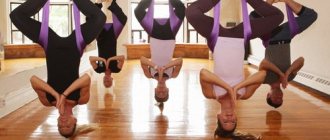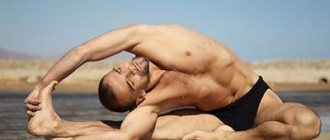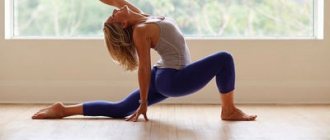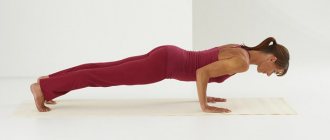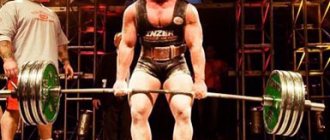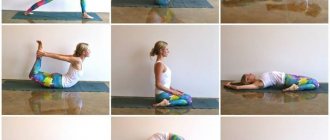Yoga
Yoga is becoming more popular every day.
Scientists are conducting studies confirming the health benefits of yoga. Millions of people choose yoga to improve their well-being and achieve a state of happiness. They don't think much about the practice's ancient history and deep philosophy. And you don’t need to bother yourself with this, because the main thing is the result. I was thinking that if you gather a group of people who are very passionate about yoga and ask them what yoga is and why it is needed, then it’s like putting a stick in a hornet’s nest. I sometimes get this feeling since I created a community about yoga on a popular social network.
From time to time, under posts in the community, comments appear from people who decide that they actually know what real yoga is. And they, of course, consider it their duty to guide the ignorant on the right path. “This is not yoga!” writes one. “That’s not what real yoga is,” shouts another.
I think such a diversity of opinions about what yoga is is due to the fact that the yoga system covers so many aspects of life. Some people need yoga to maintain good physical shape, others to cleanse the body. For such people, it is enough to go to group classes at a fitness club once a week.
But besides physical exercises, yoga also has many other practices in its arsenal.
Let's try to figure out what yoga is.
Don't forget to get your free online course on mindfulness meditation : get the course for free
There I show you the fastest and safest way to learn to meditate from scratch and bring a state of mindfulness into everyday life.
What is yoga
Yoga is also a cleansing technique for removing waste and toxins from the body.
Yoga is also a breathing exercise to calm the mind and develop the respiratory system.
Yoga is also a meditative practice for self-knowledge.
Yoga also has its own idea of the human energy structure, chakras and energy channels, and methods of developing internal energy.
Therefore, different yoga practitioners may have different goals. But still the division into 2 camps is especially pronounced. The former see yoga as an effective way to maintain health and well-being. The latter consider yoga a spiritual path to enlightenment and relief from suffering.
Physical adepts usually do not participate in disputes, but simply share their impressions or advice. Spiritual adepts periodically come across these tips and begin to explain to careless “gymnasts” that real yoga is not gymnastics, but something much more.
To be honest, I am one of those who consider yoga to be more than just physical exercise. But I am categorically against this opinion being imposed on those who simply like to do asanas without going into philosophy.
In the end, yoga exercises are very effective in terms of health, they help to stretch the body, tendons and strengthen joints. Asanas also increase the tone of the nervous system, improve blood circulation and strengthen the immune system.
I think these benefits are enough to just do the physical exercises of yoga.
When you hear the words “yoga is...” always use critical thinking and don’t believe everything they say. Don’t forget about scammers who take advantage of people’s trust and faith in miracles for the purpose of profit. Many famous yoga masters who draw crowds to their seminars are simply businessmen and nothing more. Of course, there are also real masters who have dedicated their lives to the study of yoga and feel a true need to help people with their knowledge. Just be careful and remember to think for yourself.
Benefit
The main goal of power yoga is to strengthen the muscular frame and musculoskeletal system. Dynamic exercises prevent joints from becoming stiff and allow the spine to be flexible and maintain a healthy, beautiful posture. Balance exercises improve coordination. In general, the practice has a positive effect on the cardiovascular and nervous systems. It can be performed every day; it does not cause emotional fatigue; on the contrary, it improves overall tone and mood.
Don’t forget about the external effect that power yoga produces. Regular exercises with a gradual increase in the number of approaches and degree of load form an athletic figure. In this case, no additional projectiles are needed, with the exception of your own body weight.
What does the word yoga mean?
Even on this question of what the word “yoga” means, scientists studying the ancient language Sanskrit have not come to a consensus. Because this word has several meanings.
There are two main versions:
- Yoga is translated as “union”, “unity”. In this sense, it is customary to understand yoga not as a process, but as the ultimate goal of practice. That is, yoga is a spiritual state of unity with the Universe, unity of mind and body, or simply inner harmony.
- Yoga is translated as “restraint”, “harness”. This meaning has more to do with the practice itself rather than the goal. The main component of yoga exercises is control over feelings and thoughts.
Why is yoga needed? 5 Essential Aspects of Yoga
- Physical development. Body training and health maintenance
- Therapy. Includes body cleansing, breathing and physical exercises. Helps restore health and cure diseases.
- Lifestyle. Many people follow the moral principles of yoga in their lives, which will be discussed further. They do not eat meat, do not wear fur coats, trying to cause less harm to nature and the people around them. The lifestyle of a modern yogi also includes daily practice of asanas, meditation and breathing exercises.
Types of yoga
- Hatha yoga. The most famous and popular type of yoga in Russia and the West. These are just physical exercises - asanas. Hatha yoga classes can be found in any fitness club or yoga studio. Hatha yoga is considered the first, simplest stage of yoga. It focuses on working with the body. The yoga system places great emphasis on a healthy lifestyle and cleanliness of the body. Achieving higher states of consciousness requires a lot of energy and possibly many years of life. And for this you need to have good health.
- Kundalini yoga. The second most popular type of yoga. In kundalini yoga, the emphasis is on working with subtle energy and energy centers - chakras. It is believed that the state of a person’s energy affects all aspects of life: financial well-being, health, happiness, personal life, mental abilities. Also, adherents of kundalini yoga claim that the level of development of various chakras directly determines character traits. For example, the third chakra - manipura, is responsible for willpower, and the fourth - anahata, for the ability to love the world around us. By developing the chakras, the practitioner develops as a person, improving his ability to interact with the world.
- Tantra yoga. Tantra is called the most ancient yoga. Its essence is the awareness of unity with the world, with all people and living beings. In general, tantra yoga can be combined with kundalini yoga. Both of these systems work with powerful spiritual energy called kundalini. In the Western world, tantra is often called some unusual type of sex. This is a big misconception. Some tantra yoga practices do involve sex, but this is only a small part of the complex teachings of tantra.
- Karma yoga. Karma yoga is a philosophical teaching that is based on the law of cause and effect. Karma yoga teaches that everything that happens in a person’s life is a consequence of his past feelings, thoughts and actions. And the main reason that unites all thoughts, feelings and actions is a person’s desire to receive and appropriate the result of his actions. This teaching is very simple, but difficult to understand without preparation.
- Raja Yoga. Raja yoga is translated from Sanskrit as “royal yoga.” This type is also called the “eightfold path” or Ashtanga yoga. Raja Yoga consists of eight steps. This is perhaps the most popular yoga system in our country, going beyond “fitness”. The system includes work with the body, moral principles, and breathing exercises. The Eightfold Path of Yoga is based on the ancient and authoritative text Yoga Sutras by Patanjali.
Where to do yoga
It is better to have an experienced yoga instructor introduce you to asanas and pranayamas. The easiest way is to come to a yoga studio for a group class. The instructor will tell you about the various nuances of practice, correct your mistakes, and talk about safety precautions.
If you don't mind spending money to improve your practice, book an individual yoga lesson with an instructor. A private instructor can be found on ad sites such as Avito or Pro ru.
An individual lesson will be more effective, since the instructor will devote all his time to you, without being distracted by other students. But such a lesson will cost several times more than a group class in a yoga studio.
If you live in a small town and don’t have the opportunity to attend a group class, do yoga using video lessons. The Internet is filled with yoga videos, courses and marathons. Of course, in this case, the instructor will not be able to control the correctness of your performance of asanas. But it's better than nothing. Technological progress has given us quick and convenient access to a huge amount of information. At least we don't have to travel to the Himalayas for years now to get a yoga lesson.
Asanas for beginners
Exercises for beginners are distinguished by the fact that they are not only effective, but also quite simple. If you do them correctly, you can make the muscles of all groups work. It is precisely with asanas for beginners that neophytes need to get acquainted with power yoga. Then they move on to the basic course.
There are five of the most popular, simple and useful exercises for your figure:
- Position "Warrior". You need to stand up straight with your arms extended along your body. Then a lunge is made with one leg, while it bends at the knee so that a right angle is formed in the knee area. During lunges, the second leg does not change its position. Taking a step forward, the practitioner should raise his arms up. During each lunge, you must keep your body motionless for 80 seconds.
- Asana "Sumoist". The student stands up straight, legs spread wide and feet turned away from himself. This position is similar to the one taken by sumo wrestlers before a fight. The hands are joined with the palms where the thoracic region of the body is located. The goal is to lower yourself down as far as possible, bending your knees. Having lowered yourself as far as possible, you need to stay in the position for 80 seconds before returning to a standing position.
- Asana "Six points". As the name itself suggests, the essence of the asana is to touch the ground with six points on the body. To do this, you should lie on your stomach, place your palms on the floor, pressing your shoulders to your body. Then, the pelvis rises up, the head looks forward, and the knees touch the floor, the toes of the feet and the palms.
- Asana "Sage". To perform it, you need to sit on the floor on one thigh with your leg extended. The second leg is lunged so that it intersects with the one lying on the floor. The body is positioned level and facing forward. One arm - the outside one - is straightened and rests on the floor. The second hand - the one closest to the legs - is raised above the head so that an even line is formed that can be drawn from one hand to the other.
- Asana "Boat". This exercise is great for training your abs. The student should lie on his back with his arms extended along the body. Then the head is raised above the floor so that the chin reaches towards the chest. The legs, while remaining extended, also rise above the ground to a height of at least 10 cm. The hands reach for the legs. The muscles should be tense for the entire 80 seconds while the person is in this position.
As the novice yogi improves the skills of performing the proposed exercises, the trainer can complicate them and increase the time during which the body is in a static position. The main thing is that the beginner’s body does not feel overstrained and the loads are the same on all muscle groups. Before asanas, gymnastics are performed to warm up.
In the future, the lesson can take place at home if the beginner has mastered performing asanas. It is better to start studying under the guidance of a professional who will outline the program step by step.
What to wear and what to pack
There are special clothes for yoga. But it is no different from ordinary sportswear. If you are already into fitness, then the same yoga clothes will suit you. The main thing is that you feel comfortable practicing and be in a variety of poses, including inverted asanas. You should also choose clothes to avoid being too hot or cold. I think you understand this perfectly well even without this article.
What to take with you? If you go to a yoga studio or fitness club, they usually provide everything you need. This includes a yoga mat, bolsters, belts and blankets. All this equipment serves for a safe, slow entry into practice. You need a rug to lay it on the floor or the ground. So that the surface on which you practice is non-slip and not too hard. This is important for safety.
If the yoga studio does not provide its visitors with a mat, purchase one at any sports store, but it is better to visit a specialized yoga store. Because ordinary manufacturers of sports goods do not always understand the specifics of yoga exercises, and such mats often slip. And this is fraught with injury.
Also, the advantage of having your own yoga mat is that it is hygienic. After all, a number of visitors have already practiced on the mat that the yoga studio will give you, which means that the mat has absorbed their dirt and sweat.
For men
Power yoga works a little differently for men than for women. The emphasis here falls more on developing the muscular frame and increasing endurance. Improves plasticity and mobility of joints. This gradual healing effect is what distinguishes power yoga from other types of physical activity. Regular muscle training turns a man into a static relief mountain; the practice of power yoga, on the contrary, preserves the flexibility of the body, ease of movement, with the concomitant acquisition of noticeable muscle strength.
When to do yoga
If you have the opportunity to freely choose the time to practice yoga, you are a happy person! The best time to practice yoga is dawn. You probably felt that early in the morning, when the sun rises, some special subtle feeling and mood is born. Even thoughts change their usual course. What seemed important in the evening fades into the background, giving way to eternal values. It’s not for nothing that they say that the morning is wiser than the evening.
Another benefit of morning exercise is an empty stomach. The effectiveness of the asana directly depends on the emptiness of the stomach. It is not recommended to eat 3 hours before a yoga class and at least an hour after practice.
Of course, this does not mean that you cannot do yoga in the evening or during the day. As much as possible and even necessary. If you can't or don't want to go to bed at 8 pm and wake up at 5 am like they do in India, do yoga in the evening and don't worry about anything. But still try not to overeat before practice.
Possible disadvantages
But when starting to practice power yoga, you need to know that the exercises only seem easy to perform and are absolutely harmless to the body. You cannot start classes without consulting an instructor. A competent specialist will be able to help you work on your muscles at the initial stage. Otherwise, power yoga can bring harm rather than benefit.
Power yoga is accessible to everyone, but despite this, it requires a certain physical form. People who have not previously exercised or maintained an active lifestyle will find it quite difficult to cope with heavy loads.
It won't be easy, but it's still worth a try. A beginner’s loads should increase gradually, and then the desired rhythm of exercises will soon be mastered. Working with a good instructor, a beginner will easily master the basic asanas and will truly enjoy the classes.
